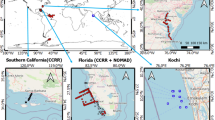Abstract
The two main inherent optical properties (IOPs) namely absorption and back scattering coefficients were estimated using a quasi analytical algorithm (QAA) for open and coastal ocean waters of Arabian Sea. Absorption due to gelbstoff and back scattering due to the particulate matter were calculated using the quasi analytical algorithm for all the in-situ measured reflectance spectra collected in the Arabian Sea. A comparative study was made to study the spectral variability of reflectance spectra in open as well as coastal waters of Arabian Sea. Spectral analysis was made for the absorption and back scattering coefficients calculated using the QAA for both open and coastal waters. The absorption coefficient in the open ocean waters vary from a minimum value of 0.029 to a maximum value of 0.445 and it varies from a minimum value of 0.081 to a maximum value of 4.000 for the coastal waters of Arabian Sea. Absorption due to gelbstoff or the CDOM ag(λ), calculated for the Arabian Sea waters show a variation of 0.000202 to 0.112437 for open ocean waters and it varies from 0.002848 to 2.8936 for coastal waters of Arabian Sea. Particulate back scattering coefficient for open ocean waters vary from 0.0000307 to 0.006575 whereas bbp(λ) vary from 0.000167 to 0.026014 for coastal ocean waters. The minimum slope for the open ocean waters is 0.989 and maximum value of 2.147 (average value of 1.7) was observed; whereas a minimum value of 0.046 and a maximum value of 1.201 (average value of 0.6) were observed from the in-situ spectra for coastal waters of Veraval. The slope ‘Y’ estimated from the model is 1.957 for open ocean waters and 0.515 for coastal waters collected in the Arabian Sea.






Similar content being viewed by others
References
Babin, M., Stramski, D., Ferrari, G. M., Claustre, H., Bricaurd, A., Obolenski, G., et al. (2003). Variations in the light absorption coefficients of phytoplankton, nonalgal particles, and dissolved organic matter in coastal waters around Europe. Journal of Geophysical Research, 108(C7), 3211. doi:10.1029/2001JC000882.
Bricaurd, A., Morel, A., & Preiur, L. (1981). Absorption by dissolved organic matter of the sea (Yellow substance) in the UV and visible domains. Limnology and Oceanography, 26, 43-53.
Carder, K. L., Chen, F. E., Lee, Z. P., Hawes, S., & Kamykowski, D. (1999). Semi-analytic MODIS algorithms for chlorophyll-a and absorption with bio-optical domains based on nitrate-depletion temperatures. Journal of Geophysical Research, 104(3), 5403–5421.
Desa, E., Suresh, T., Matondkar, S. G. P., Ehrlich, D., Goes, J., Mascarenhas, A., et al. (2005). Detection of Trichodesmium bloom patches along the eastern Arabian Sea by IRS-P4/OCM ocean ocean color sensor and by in-situ measuremetns. Indian Journal of Marine Sciences, 34(4), 374–386.
Hamre, B., Frette, O., Erga, S. R., Stamnes, J. J., & Stamnes, K. (2003). Parameterization and analysis of the optical absorption and scattering coefficients in a western Norwegian fjord: a case II water study. Applied Optics, 42, 883–892.
Hu, C., Lee, Z.P., Muller-Karger, F.E., Carder, K.L.(2002). Application of an optimization algorithm to satellite ocean colour imagery: A case study in Southwest Florida coastal waters. SPIE proceedings 4892. In: R. J. Frouin, Y. Yuan, H. Kawamura (Eds.) Ocean Remote Sensing and Applications p.70-79.
Hu, C., Muller-Karger, F. E., Biggs, D. C., Carder, K. L., Nababan, B., Nadeau, D., et al. (2003). Comparison of ship and satellite bio-optical measurements on the continental margin of the NE Gulf of Mexico. International Journal of Remote Sensing, 24, 2597–2612.
Lee, Z., Carder, K. L., Mobley, C. D., Steward, R. G., & Patch, J. S. (1999). Hyperspectral remote sensing for shallow waters: 2. Deriving bottom depths and water properties by optimization. Applied Optics, 38, 3831–3843.
Lee, Z., Carder, K. L., & Arnone, R. A. (2002). Deriving inherent optical properties from water color: a multiband quasi-analytical algorithm for optically deep waters. Applied Optics, 41, 5755–5772.
Maritorena, S., Siegel, D. A., & Peterson, A. R. (2002). Optimization of a semianalytical ocean color model for global-scale applications. Applied Optics, 41, 2705–2714.
Menon, H. B., Lotliker, A. A., Krishnamurthy, K., & Nayak, S. R. (2006). Variability of remote sensing reflectance and implications for optical remote sensing – A study along the eastern and north eastern waters of Arabian Sea. Geophysical Research Letters, 33, L15602.
Miller, R. L., Belz, M., Del Castillo, C. E., & Trzaska, R. (2001). Determining CDOM absorption spectra in diverse aquatic environments using a multiple pathlength, liquid core waveguide system. Continental Shelf Research, 22, 1301–1310.
Morel, A., & Prieur, L. (1977). Analysis of variations in ocean colour. Limnology and Oceanography, 22, 709–722.
Pope, R., & Fry, E. (1997). Absorption spectrum (380–700 nm) of pure waters: II, Integrating cavity measurements. Applied Optics, 36, 8710–8723.
Reynolds, R. A., Stramski, D., & Mitchell, B. G. (2001). A chlorophyll dependent semi analytical reflectance model derived from filed measurements of absorption and back scattering coefficients within the Southern Ocean. Journal of Geophysical Research, 106, 7125–7138.
Acknowledgements
This work is supported under the MOP-II/OCEANSAT-II utilization program of Indian Space Research Organization (ISRO). The authors are thankful to Dr. Ajai, Group Director, MESG and Dr. J. S. Parihar, Deputy Director, Remote Sensing Applications Area, Space Applications Centre, Ahmedabad for their valuable advice and encouragement. We are also grateful to Dr. R. R. Navalgund, Director, Space Applications Centre, (ISRO), Ahmedabad for taking keen interest in this work.
Author information
Authors and Affiliations
Corresponding author
About this article
Cite this article
Nagamani, P.V., Chauhan, P. & Sanwlani, N. Comparison of Inherent Optical Properties (IOPs) in Open and Coastal Waters of Arabian Sea Using In-Situ Bio-Optical Data. J Indian Soc Remote Sens 39, 455–462 (2011). https://doi.org/10.1007/s12524-011-0100-8
Received:
Accepted:
Published:
Issue Date:
DOI: https://doi.org/10.1007/s12524-011-0100-8




